 Navigation is the US Army Corps of Engineers’ earliest Civil Works mission, dating to Federal laws in 1824 authorizing and funding the USACE to improve safety on the Ohio and Mississippi Rivers and several ports.
Navigation is the US Army Corps of Engineers’ earliest Civil Works mission, dating to Federal laws in 1824 authorizing and funding the USACE to improve safety on the Ohio and Mississippi Rivers and several ports.
USACE provides safe, reliable, efficient, and environmentally sustainable waterborne transportation systems (channels, harbors, and waterways) for movement of commerce, national security needs, and recreation.
Key Initiatives
- Modernizing and rehabilitating key infrastructure
- Using the Capital Investment Strategy to identify opportunities for investment in the inland system
- Improving major maintenance and rehab policies and processes to efficiently manage critical assets - locks, breakwaters, and jetties
- Leveraging consolidated/coordinated closures to complete necessary major lock maintenance and rehab
- Executing historical investment using key principles of delivery
- Strategic stakeholder & industry engagements
- Enterprise and Regional coordination and scheduling
- Use best management practices for contracting process
- Find environmentally friendly technology and innovation solutions to meet our increased maintenance, resiliency and beneficial use of dredged material goals
- Efficiently manage dredged material placement capacity
- Improve dredge material management policies and practices
- Increase beneficial reuse of dredged material to effectively manage sediment within the ecosystem
- Leverage 5-year dredged material management plans
Maintaining our Federal channels and waterways is essential for strengthening the economy, creating jobs, reducing risks, and bolstering our long-term global competitiveness and national security. The Coastal Navigation portfolio includes approximately 13,000 miles of coastal channels with 28 locks at 25 sites; and more than 1,000 other coastal navigation structures. Coastal Navigation moves approximately 2.5 billion tons of cargo annually, valued at over $8.8 Billion in 2020.
The Corps Coastal Navigation program includes the Great Lakes Navigation System (GLNS). The GLNS is an extensive deepwater navigation network that spans 1,600 miles, encompassing all five Great Lakes and connecting channels from Duluth, Minnesota, to Ogdensburg, New York.
The Coastal Navigation portfolio is operated and maintained through appropriations from the Harbor Maintenance Trust Fund.
Harbor Maintenance Trust Fund
- The Harbor Maintenance Tax (HMT) and Harbor Maintenance Trust Fund (HMTF) were established in 1986 to fund the O&M of Federal ports and harbors. The HMTF is charged against the value of imports and domestic cargo arriving at U.S. ports that have federally-maintained harbors and channels and deposited into the HMTF.
- The HMTF is authorized to recover 100% of USACE eligible operation and maintenance (O&M), eligible construction activities, and certain eligible Mississippi River and tributaries expenditures for the maintenance of commercial navigation in harbors and channels as well as 100% of the O&M cost of St. Lawrence Seaway by the St. Lawrence Seaway Development Corporation.

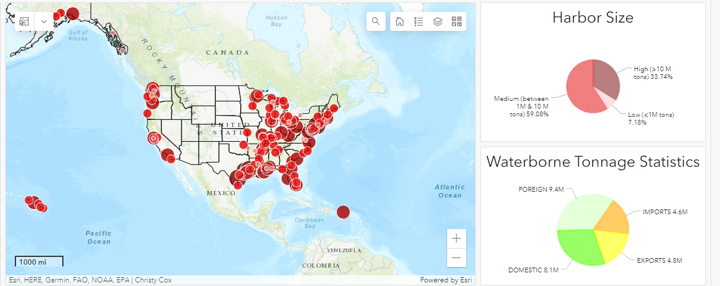
Coastal Project Commercial Use Categories (Annual tonnage)
- High Use Projects move greater than 10 million tons of cargo per year
- Moderate Use Projects move between 1 million and 10 million tons of cargo per year
- Low Use (Emerging) Projects move less than 1 million tons of cargo per year
Coastal Projects that are Eligible for HMTF O&M Funding
Total number of Coastal navigation projects: 1208 (From Sec. 1216 Report, Assessment of Harbors)
- High Use: 59 (4.9%)
- Moderate Use: 81 (6.7%)
- Low Use: 1068 (88.4%)
The Nation’s infrastructure to support transportation of commercial goods by water involves a network of navigable coastal channels, inland waterways, and related features maintained by Civil Works, as well as publicly and privately owned marine terminals, intermodal connections, shipyards and repair facilities.
- The Inland Marine Transportation System (IMTS) reliability is a critical component that enables the Nation to participate and remain competitive in the global economy.
- The portfolio includes approximately 12,000 miles of inland waterways with 209 locks at 167 sites.
- The inland waterways are appropriated funds from the Inland Waterway Trust Fund for construction and modernization activities. Our Capital Investment Strategy provides a 20 year investment strategy for making capital investments on the inland system and is updated every 5 years as directed by WRRDA 2014.
Inland Waterways Trust Fund
The Inland Waterways Trust Fund (IWTF) is a fund in the U.S. Treasury that receives revenues from a tax on commercial barge fuel ($.29/gal) on federally designated waterways. IWTF monies are subject to appropriation and available for USACE expenditures for navigation, construction, and rehabilitation projects on Federal inland waterways. Cost shares 35% of the eligible construction cost.
Inland Project Commercial Use Categories (Annual Ton-Miles)
- High Use greater than 3 billion ton-miles
- Moderate Use between 1 and 3 billion ton-miles
- Low Use less than 1 billion ton-miles
Total Fuel Taxed Waterways: 27
- High Use: 7 (25.9%)
- Moderate Use: 5 (18.5%)
- Low Use: 15 (55.6%)
USACE has launched a long-term initiative to modernize lock & dam inland and intracoastal waterways infrastructure and operations to prepare for the future of navigation. USACE is committed to strengthening its ability to deliver the navigation mission and ensuring that navigation remains as safe, reliable & consistent as it is today. USACE is at the beginning of a multi-decade, funding-dependent change that will modernize hydraulic and electro-mechanical lock and dam controls to a standardized digital control system. USACE is committed to its workforce and stakeholders and will work closely with everyone throughout this process.
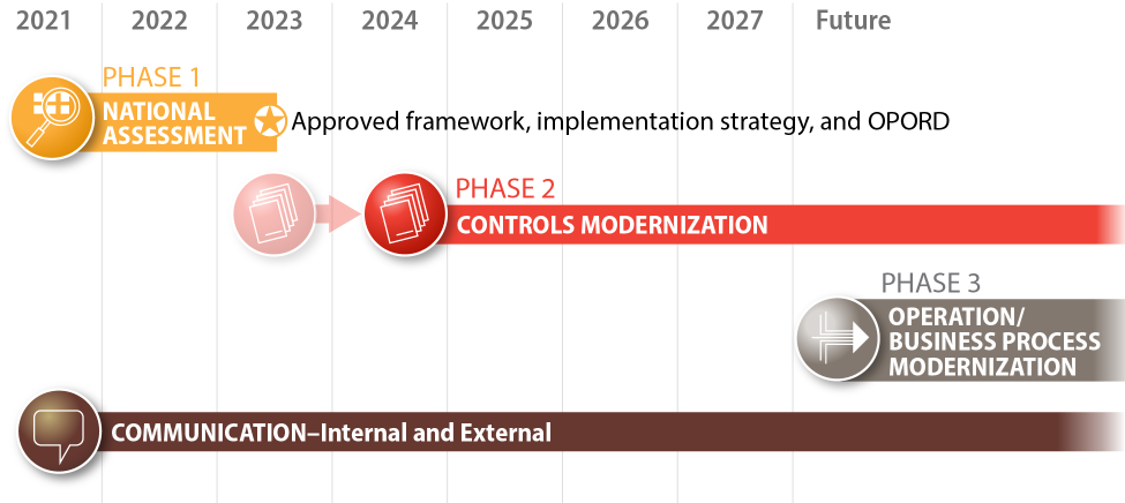

Our Mission
Safeguard and enhance the navigability, safety, and economic vitality of waterways through comprehensive response efforts
using state of art equipment and techniques
BRIEF PROGRAM HISTORY
Much of the early navigation clearing, snagging, and dredging technology in the United States was developed by the Corps while building its fleet of dredges and other floating plant assets.
The early Corps dredges were active in the U.S. Wartime efforts in World War II and in Vietnam.
|
Prior to 1978
The Corps’ owned over 79 pieces of dredge plant that were used to build the nation’s navigation infrastructure and assist in U.S. wartime efforts around the world.
|
April 1978
Public Law 95-269 “Industry Capability Program” was passed to encourage the growth of private dredging industry. This also set the direction for establishing a minimally owned federal dredge fleet.
|
FLEET CORE COMPETENCIES


 |
 |
 |
|
EQUIPMENT OPERATIONS
|
FABRICATION & MACHINING
|
FIELD WORK
|
- Floating Crane/ LHE Operations
- Towboats, Derrickboats, Wicket Lifters
- Floating Plant Operations and Maintenance
- Earth Moving/Material Handling
|
- Conventional and CNC Machining
- Welding and Ironworking
|
- Mobile Line Boring and Welding
- Structural Weld Repairs
- Modifications of Structures
- Skilled Troubleshooting and Problem Solving
|
FLEET CAPABILITIES

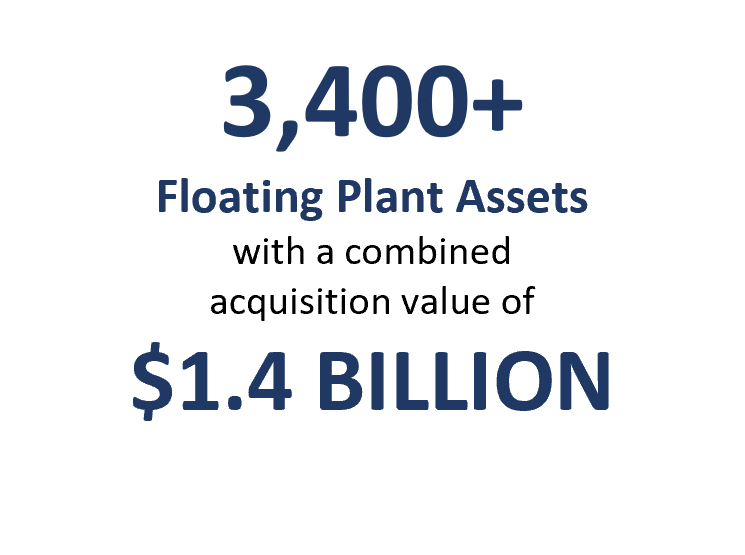

The U.S. Army Corps of Engineers is dedicated to keeping America’s waterways open and thriving. By employing innovative dredging techniques and partnering with federal, state, and local governments, USACE ensures the safe and efficient movement of goods that power our economy. We strive to enhance the environment through beneficial use dredging, with a goal of repurposing 70% of dredged material by 2030 to restore habitats, nourish beaches, and protect our coasts. Through our commitment to responsible navigation and environmental stewardship, we aim to secure a prosperous and sustainable future for all.
Fun Fact: Did you know the U.S. Army Corps of Engineers (USACE) maintains over 25,000 miles of waterways and 400 ports and harbors across the United States? In 2023 alone, they dredged over 249 million cubic yards of material—enough to fill 75 Empire State Buildings! USACE uses a variety of specialized dredges, including hoppers, cutterheads, dustpans, and clamshells, each designed for different types of waterways and sediment.
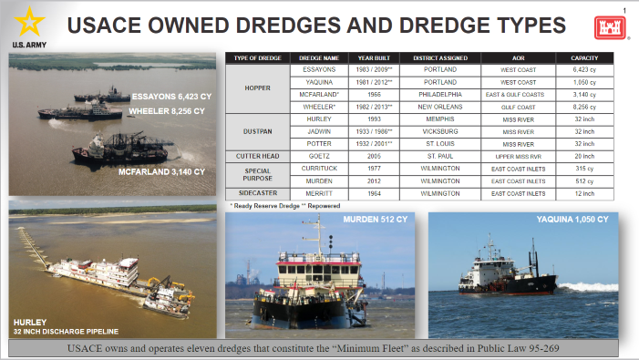
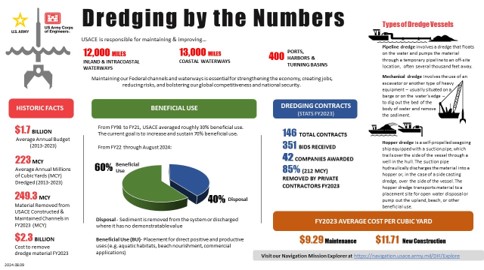

The U.S. Army Corps of Engineers routinely creates value from dredged sediments through beneficial use of dredged material (as defined by USACE Beneficial Uses of Dredged Material, Engineer Manual 1110-2-5026). Currently, of the approximately 200-300 million cubic yards of material dredged annually, the USACE uses approximately 40% of that beneficially. In January 2023, through a Command Philosophy Notice, the Chief of Engineers set the goal to increase that to 70% beneficial use by 2030.
The USACE has the authority to maintain navigable waterways through the Rivers and Harbors Act of 1899, and all subsequent WRDAs. Placement of material is regulated by the Clean Water Act and the Marine Protection, Research, and Sanctuaries Act. Operation and Maintenance of USACE Navigation projects is outlined in 33CFR 335-338, which includes a definition of the Federal Standard. A full list of Environmental Laws and Regulations applicable to Dredged and Dredged Material Disposal Activities is listed below:
1. National Environmental Policy Act of 1969
2. Clean Air Act of 1970
- Section 309 requires EPA review of federal action agency NEPA documents
3. Resource Conservation and Recovery Act of 1976
- Dredged material excluded as a hazardous waste through 1998 rule making at 40 CFR 261.4(g)
4. Rivers & Harbors Act of 1899
- Section 10 - Permits for Structures and Activities in Navigable Waters
- Section 13 - Refuse Act. CWA subsumed the permitting provisions of Section 13 into Section 402. Enforcement provision was retained.
5. Federal Water Pollution Control Act of 1972 (amended and renamed the Clean Water Act in 1977), Title IV - Permits and Licenses
- Section 401 - Requires water quality “certification” of activities needing a federal license or permit
- Section 402 - NPDES Dredged material excluded at 40 CFR 122.3(b)
- Section 403 - Ocean Discharge Criteria
- Same criteria as at 102 of the ODA
- Section 404 - Permits for Dredged or Fill Material
- 404(b)(1) guidelines developed by EPA in conjunction with Corps
- Requires comparability in testing between Sec 404 and Sec 403 (Legal basis for ITM/OTM single manual)
- Section 405 - Disposal of Sewage Sludge
- Prohibits disposal in waters absent an EPA Permit
6. Marine Protection, Research, and Sanctuaries Act of 1972 (commonly called the Ocean Dumping Act), Title I - Ocean Dumping
- Section 102 - EPA permits for everything but dredged material. Currently two fish waste sites. Sinking ships and burial at sea general permitted
- Establish criteria for all waste and consult with Corps for criteria affecting civil works program
- Section 103 - Corps issues permits for transportation for disposal of dredged material
- Must apply EPA 102(a) criteria
- Discharge of fill in territorial sea regulated by CWA
- Disposal of dredged material in territorial sea regulated by 102(a) criteria. See 40 CFR 230.2(b)
7. Coastal Zone Management Act of 1972
- Section 307 - Coordination and Cooperation
8. Endangered Species Act of 1973
- Section 7 - Interagency Cooperation
9. Fish and Wildlife Coordination Acts of 1934, 1956, and 1958
10. National Historic Preservation Acts of 1966 and 1980
11. Submerged Lands Act of 1953
12. Magnuson-Stevens Fishery Conservation and Management Act (MSA)